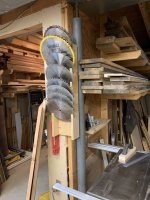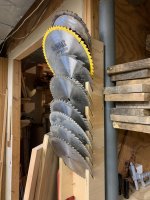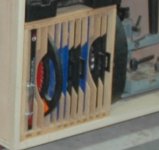- Messages
- 8,271
- Location
- Williamette Valley, Oregon
I'm revamping a bit of the area around my tablesaw (yaah new router extension) and I think I can move my tablesaw blade storage over there as well if I lay it out right which will clear out some space in some other cabinets. The new space will all be custom built so I have ample opportunity to do it all wrong.
I'm starting to design the space where the tablesaw blades would fit into this and am wondering what everyones thoughts are on standing the blades on edge vs a hanging system vs laying them flat. The temptation is to just have a big enough drawer and layer them in, but I'm also unconvinced that's the "optimal" design so I'm looking for some ideas from the crowd.
The dado stack is already in a carrier which can either stand upright or hang so I'm thinking I might just designate a space to hang it on the side. This would be mostly the "rest of the blades", I probably have half a dozen +- (but could see maybe a dozen total so not huge).
I'm starting to design the space where the tablesaw blades would fit into this and am wondering what everyones thoughts are on standing the blades on edge vs a hanging system vs laying them flat. The temptation is to just have a big enough drawer and layer them in, but I'm also unconvinced that's the "optimal" design so I'm looking for some ideas from the crowd.
The dado stack is already in a carrier which can either stand upright or hang so I'm thinking I might just designate a space to hang it on the side. This would be mostly the "rest of the blades", I probably have half a dozen +- (but could see maybe a dozen total so not huge).




